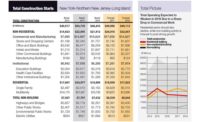The 30 ft diameter of the shafts will serve as the delivery mechanism for the tunnel boring machine (TBM) that will chew through the 2.5 miles of bedrock under the river from shaft 5B to shaft 6B. The new tunnel will run parallel to the old tunnel but about 100 ft to the north of it.
The contractors have not yet decided on the vendor for the TBM, but the field has been narrowed to either Herrenknecht AG of Schwanau, Germany, or The Rob- bins Co. of Solon, Ohio. In either case, the machine will be custom-built for the job because of the pressures involved in tunneling 600 ft below the Hudson at about 300 pounds per square inch.
McAndrew estimates that the machine will cost be- tween $20 million and $30 million and will have a 9-ft stroke, making it capable of clearing about 30 ft of rock on an average day.
A crew of 12 workers will follow behind the TBM, aiding in the machine’s operation and maintenance and bolting together the rail sections that enables the back portions of the TBM to move forward as its 60 to 70 carbon steel cutting heads chew through the rock.
The detritus will move through the TBM to muck cars that will ride on the rails to the shaft where they will be lifted to the surface, most likely by a crane. Consisting of chunks about 1 inch or less in dia., the 300,000 cubic yards of ground-up rock will be re- moved from the tunnel and used at an adjacent 30- acre site that New York City acquired from local home- owners. There, the topsoil will be removed, and rock from the tunnel excavation will be used to level off the land. The topsoil will then be put back in place.
The city has not yet decided what it will do with the site when the project is finished.
Much of the detritus from the shafts is being used in the staging area around the shafts.
Having an adjacent site for tunnel material will re- duce the project’s carbon footprint, as well as reduce truck traffic along Route 9W, DEP spokesman Adam Bosch says.
As the TBM bores a 20-ft-dia. tunnel through the rock, construction crews will begin setting precast concrete sections in place in the tunnel. Inside that, they will install 11,000 ft of 1-inch thick steel plate that will be welded together to line the tunnel. And, finally, the tunnel will be finished with 1 ft of reinforced concrete liner, bringing the final interior diameter to 14 ft.
When the new tunnel is completed the TBM will either be dismantled and removed through the Wappinger shaft or abandoned.






Post a comment to this article
Report Abusive Comment